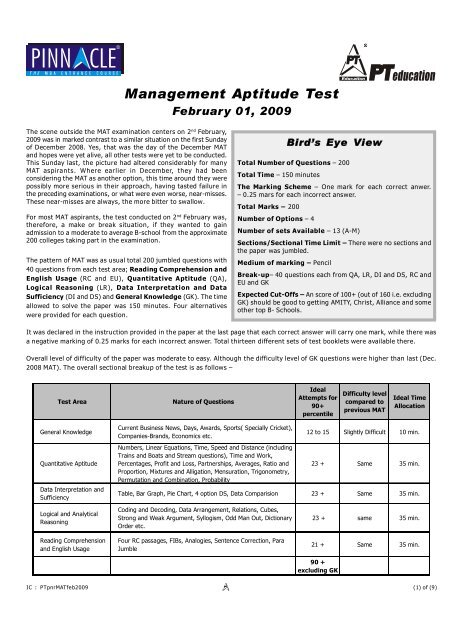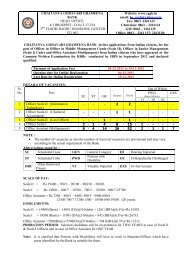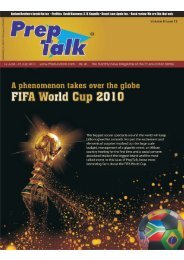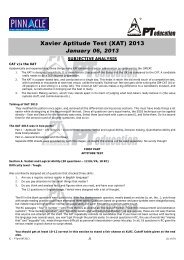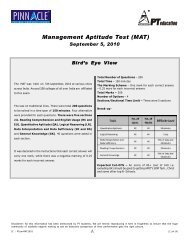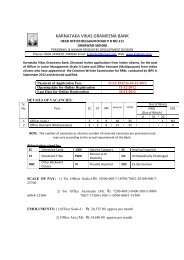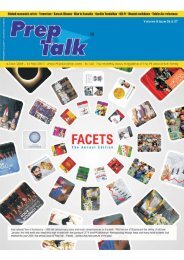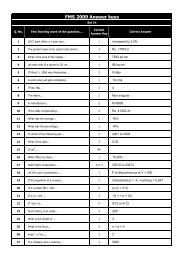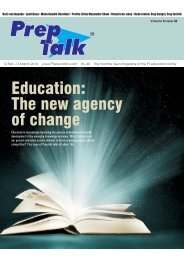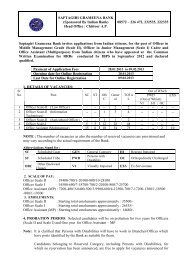Management Aptitude Test - PT education
Management Aptitude Test - PT education
Management Aptitude Test - PT education
Create successful ePaper yourself
Turn your PDF publications into a flip-book with our unique Google optimized e-Paper software.
<strong>Management</strong> <strong>Aptitude</strong> <strong>Test</strong><br />
February 01, 2009<br />
The scene outside the MAT examination centers on 2 nd February,<br />
2009 was in marked contrast to a similar situation on the first Sunday<br />
of December 2008. Yes, that was the day of the December MAT<br />
and hopes were yet alive, all other tests were yet to be conducted.<br />
This Sunday last, the picture had altered considerably for many<br />
MAT aspirants. Where earlier in December, they had been<br />
considering the MAT as another option, this time around they were<br />
possibly more serious in their approach, having tasted failure in<br />
the preceding examinations, or what were even worse, nearmisses.<br />
These nearmisses are always, the more bitter to swallow.<br />
For most MAT aspirants, the test conducted on 2 nd February was,<br />
therefore, a make or break situation, if they wanted to gain<br />
admission to a moderate to average Bschool from the approximate<br />
200 colleges taking part in the examination.<br />
The pattern of MAT was as usual total 200 jumbled questions with<br />
40 questions from each test area; Reading Comprehension and<br />
English Usage (RC and EU), Quantitative <strong>Aptitude</strong> (QA),<br />
Logical Reasoning (LR), Data Interpretation and Data<br />
Sufficiency (DI and DS) and General Knowledge (GK). The time<br />
allowed to solve the paper was 150 minutes. Four alternatives<br />
were provided for each question.<br />
Bird’s Eye View<br />
Total Number of Questions – 200<br />
Total Time – 150 minutes<br />
The Marking Scheme – One mark for each correct anwer.<br />
– 0.25 mars for each incorrect answer.<br />
Total Marks – 200<br />
Number of Options – 4<br />
Number of sets Available – 13 (AM)<br />
Sections/Sectional Time Limit – There were no sections and<br />
the paper was jumbled.<br />
Medium of marking – Pencil<br />
Breakup– 40 questions each from QA, LR, DI and DS, RC and<br />
EU and GK<br />
Expected CutOffs – An score of 100+ (out of 160 i.e. excluding<br />
GK) should be good to getting AMITY, Christ, Alliance and some<br />
other top B Schools.<br />
It was declared in the instruction provided in the paper at the last page that each correct answer will carry one mark, while there was<br />
a negative marking of 0.25 marks for each incorrect answer. Total thirteen different sets of test booklets were available there.<br />
Overall level of difficulty of the paper was moderate to easy. Although the difficulty level of GK questions were higher than last (Dec.<br />
2008 MAT). The overall sectional breakup of the test is as follows –<br />
<strong>Test</strong> Area<br />
Nature of Questions<br />
Ideal<br />
Attempts for<br />
90+<br />
percentile<br />
Difficulty level<br />
compared to<br />
previous MAT<br />
Ideal Time<br />
Allocation<br />
General Knowledge<br />
Quantitative <strong>Aptitude</strong><br />
Data Interpretation and<br />
Sufficiency<br />
Current Business News, Days, Awards, Sports( Specially Cricket),<br />
CompaniesBrands, Economics etc.<br />
Numbers, Linear Equations, Time, Speed and Distance (including<br />
Trains and Boats and Stream questions), Time and Work,<br />
Percentages, Profit and Loss, Partnerships, Averages, Ratio and<br />
Proportion, Mixtures and Alligation, Mensuration, Trigonometry,<br />
Permutation and Combination, Probability<br />
12 to 15 Slightly Difficult 10 min.<br />
23 + Same 35 min.<br />
Table, Bar Graph, Pie Chart, 4 option DS, Data Comparision 23 + Same 35 min.<br />
Logical and Analytical<br />
Reasoning<br />
Reading Comprehension<br />
and English Usage<br />
Coding and Decoding, Data Arrangement, Relations, Cubes,<br />
Strong and Weak Argument, Syllogism, Odd Man Out, Dictionary<br />
Order etc.<br />
Four RC passages, FIBs, Analogies, Sentence Correction, Para<br />
Jumble<br />
23 + same 35 min.<br />
21 + Same 35 min.<br />
90 +<br />
excluding GK<br />
IC : <strong>PT</strong>pnrMATfeb2009 (1) of (9)
The ideal strategy to solve the paper should be –<br />
1. In first 1015 minutes scan all the GK questions and attempt 12 to 15 questions on which you are absolutely sure.<br />
2. After that start picking easy solvable questions from start of the paper.<br />
The questions from CodingDecoding, Numbers, Fractions, Arithmetic, Para Jumbles, FIBs, Analogies, Data Arrangement,<br />
Syllogism, Data Comparison and the DI sets containing the Pie Charts etc. can be included in this round. 1517 questions from<br />
LR, 1012 questions from GK, 1315 questions from QA, 1315 questions from DI & DS and 68 questions from EU could have<br />
been attempted first.<br />
3. After the first round of attempts, the student should have attempted the tougher questions. Questions based on DI sets<br />
containing tables and Bar graph, questions from Mensuration, Height and Distance, some questions of mixtures, work and<br />
time, the strong and weak argument questions, questions on cubes, reading of RC passages, sentence correction question<br />
etc. could have been attempted in this round.<br />
Ideally a student, who was good at question selection , could have attempted 50 to 55 questions in the first hour<br />
itself.<br />
Topic<br />
No. of<br />
Que.<br />
The questions from the areas like Numbers, Fractions, SI and CI, Time<br />
Speed and D i st ance (incl udi n g Trains), Races, Avera ges,<br />
Numbers 4<br />
Percentages, Work and Time (including Pipes and Cisterns), Profit Linear Equations 1<br />
and Loss, Mixt ures, Profi t and Loss, Cal endar, Rat io and<br />
Proportion, Mensuration, Height and Distances, Probability, Ratio and Proportion, Mixture and Alligation 4<br />
Permutation and Combination, were the representative of QA area.<br />
The questions were of moderate level of difficulty. For a well prepared<br />
Percentage, Profit and Loss, Partnership 10<br />
student on an average not more than 11.5 minutes would be required to Work and Time 5<br />
solve one question of this area.<br />
Time Speed and Distance<br />
(including Boats and Stream and Trains)<br />
6<br />
To check the students' logical and analytical abilities there were questions<br />
on Direction Sense, Calendar, Relations, Linear and Matrix<br />
arrangements, Strong and Weak Argument, CodingDecoding and<br />
Cubes. Excluding some questions based on Direction Sense and Data<br />
Arrangement all other questions were of easy level. One could attempt 23+<br />
questions in a time span of 35 minutes from this area.<br />
Mensuration 3<br />
Height and Distance 2<br />
Permutation and Combination 3<br />
Probability 2<br />
There were total four RC passages and 20 questions were asked based on<br />
these passages. The themes of the RC passages were: Terrorism,<br />
Problems in grooming of SMEs, Henry Ford’s inane passion for<br />
automobiles, Exchange of gases and diffusion of water in eggs.<br />
The length of the passages was of approx. 1100, 800, 1200 and 450<br />
words respectively and 5 questions were asked from each passage. The<br />
questions asked were moderate level of difficulty.<br />
Topic<br />
No. of<br />
Que.<br />
Relations 2<br />
Direction Sense 3<br />
Cubes 3<br />
Source of RC Passages –<br />
Terrorism http://www.centralchronicle.com/20090110/1001301.htm<br />
Henry Ford – www.campusconnect.com/students/<br />
download.php?path=samplepapers/<br />
<strong>Aptitude</strong>_Sample_Paper.pdf&file=<strong>Aptitude</strong>_Sample_Paper<br />
Exchange of gases and diffusion of water in eggs K Tona, E<br />
Decuypere, W Coucke British Poultry Science, 2001<br />
From EU area there were questions on FIBs two blanks (3), Identify<br />
the Best way of Writings (4), Analogies (4), Para Jumble (4) and<br />
Sentence Correction (5). The questions were of moderate level of<br />
difficulty.<br />
Data Arrangement 15<br />
Strong and Weak Argument 4<br />
Dictionary Arrangement, Odd One Out<br />
and Other questions<br />
Alphabet <strong>Test</strong> 2<br />
Clocks 2<br />
Syllogims 4<br />
5<br />
(2) of (9)<br />
IC : <strong>PT</strong>pnrMATfeb2009
The GK questions were a mixture of easy and moderately difficult questions. The questions were on dynamic as well as traditional GK.<br />
There were questions on Economics, Current Affairs, Awards and Prizes, Days. Since this area was only to pass and marks of this<br />
will not be include in merit, an attempt of 1215 questions will be sufficient to achieve the cutoff for this area.<br />
We have recalled some of the questions which are as follows –<br />
1. The automobile brand “Hayabusa” is from which company? –<br />
2. World Consumer Day observed on –<br />
3. Kalpakkam is situtated in which state? –<br />
4. Which of the following companies are the staturay auditor for Satyam? –<br />
5. Sachin Tendulkar achieved 10,000 runs record in test cricket by breaking which of the following batsman’s record?<br />
6. Which of the following batsman recently become the sixth batsman to achieve the 10,000 runs in test cricket?<br />
7. Who is the booker prize (literature) winner 2008? –<br />
8. Who is the recipient of Bharat Ratna 2008?<br />
9. Which of the following award is given by UNESCO in the achievement of science in daily life?<br />
Directions: Read the following passages and answer the questions that follow.<br />
Passage I<br />
Source – http://www.centralchronicle.com/20090110/1001301.htm<br />
8. The author’s main aim is to<br />
I. inform people about the recent terrorist attack in Mumbai<br />
II. identify the root causes of terrorism<br />
III. suggest ways to tackle the threat of terrorism<br />
(1) I, II and III (2) II and III only (3) I only (4) II only<br />
9. As per the passage, which of the following is not true?<br />
(1) Persons with disrupted identity are soft targets for recruitment by terrorist organizations.<br />
(2) High quality intelligence, political support and cooperation of neighbouring countries are all needed to tackle the threat<br />
posed by terrorism.<br />
(3) Existing laws are adequate to deal with terrorism and organized crime, provided full political support is assured.<br />
(4) Terrorism in India originiates both internally and externally.<br />
10. Which of the following captions would most aptly sumup the contents of the passage?<br />
(1) India’s Brave response to the Threat of Terrorism.<br />
(2) Is Terrorism a Global Threat?<br />
(3) Terrorism is a Psychological Phenomenon.<br />
(4) Root Cause of Terror; Ways to Deal with the Menace.<br />
11. Which of the following is not implied in the passage?<br />
(1) The November 2008 terror attack in Mumbai evoked strong support to India from across the globe.<br />
(2) Rudi Giulani the Mayor of New York, displayed exemplary leadership at the time of 9/11.<br />
(3) The people of India should play the role of watchdog in monitoring the government’s response to the threat posed by<br />
terrorism.<br />
(4) Security forces alone can tacklet all problems if given full freedom.<br />
12. As per the passage which of the following statements is true?<br />
I. Over a long period of time terrorism gradually fades out.<br />
II. The NIA, when set up, could independently tackle all terrorismrelated issues.<br />
III. Terrorism has strong links with other forms of organized crime.<br />
(1) III only (2) I and II only (3) I only (4) I, II and III<br />
IC : <strong>PT</strong>pnrMATfeb2009 (3) of (9)
Passage III<br />
Source – www.campusconnect.com/students/download.php?path=samplepapers/<strong>Aptitude</strong>_Sample_Paper.pdf&file=<strong>Aptitude</strong>_Sample_Paper<br />
18. “Every clock in the village shudders when it sees Henry coming.” Why did Henry’s neighbour make this joke?<br />
(1) Henry had no interest in farming, as every other villager did.<br />
(2) The whole world of the protagonist lay around machines.<br />
(3) Mechanical contraptions fascinated Henry.<br />
(4) None of these<br />
19. The example of the engine driver is given by the author top whicho f the following character traits of Henry Ford?<br />
(1) Challenging (2) Contemplative (3) Inquisitive (4) Perseverant<br />
20. The role of Clara in the success of Henry Ford can best be described in the following words:<br />
(1) she should be given equal accolades for Ford’s success.<br />
(2) she was not exactly a part of his success.<br />
(3) she was with him as a great support and a great friend.<br />
(4) cannot be derived from the passage.<br />
21. “Horseless Carriage” – this was the dream of Henry Ford. He got a mojor cue from Dr. Nicolaus Otto. This cue was in the form of<br />
(1) the confidence, which he got from Dr. Otto’s discovery.<br />
(2) the idea, which he got from Dr. Otto’s discovery.<br />
(3) material help which Dr. Otto gave him.<br />
(4) All these<br />
22. What is the normal relation between parental expectations and the natural proclivities of the progeny, as per the passage?<br />
(1) They have no definite relation.<br />
(2) Natural proclivities suprimpose the parental expectations.<br />
(3) They are often on different paths.<br />
(4) Parental expectations build natural proclivities or, natural proclivities are inherent.<br />
Passage IV<br />
Source – K Tona, E Decuypere, W Coucke British Poultry Science, 2001<br />
23. The passage is primarily concerned with<br />
(1) explaining the processes of gas and water diffuion in eggs.<br />
(2) explaining difficulties involved in cultivating domestic fowl.<br />
(3) explaining the origin of passive diffusion as a method of respiration.<br />
(4) distinguishing between passive diffusion and active respiration.<br />
24. A necessary ingredient in the eggshell’s suitability for gas exchange is its<br />
(1) permeability (2) opacity (3) fragility (4) adhesiveness<br />
25. The passage contains information that would answer which of the following questions about fowlbreeding?<br />
I. What function does turning the fertilized egg serve in the hatching process?<br />
II. Why must the egg shed water during the hatching process?<br />
III. What occurs when the amount of water loss during hatching exceeds 15 percent of the egg’s initial mass?<br />
(1) I and II only (2) II only (3) I only (4) II and III only<br />
26. The passage would be most likely to appear in<br />
(1) a Congresional report urging the appropriation of funds for reasearch into needed improvements in egghatching<br />
(2) a pamphlet designed to introduce novice breeders of domestic fowl to the advantages of current techniques.<br />
(3) an agricultural research report focused on the history of fowlbreeding practices in the current techniques.<br />
(4) a scientific journal article highlighting biochemical is true of the extent of water loss by comon phenomena<br />
(4) of (9)<br />
IC : <strong>PT</strong>pnrMATfeb2009
Directions: Select the pair of words, which exhibits the same relationship between each other as the given capitalized pair of words.<br />
27. CACOPHONOUS : HARMONIOUS ::<br />
(1) tempestuous : stormy (2) beauty : peace (3) bellicose : pacific (4) considerate : sympathetic<br />
28. mitigate : punishment ::<br />
(1) monotonous : change (2) place : placement (3) change : order (4) alleviate : pain<br />
29. praise : extol ::<br />
(1) insure : rely (2) stuff : cram (3) hurry : run (4) dislike : loathe<br />
30. inspid : piquant ::<br />
(1) sweet : dessert (2) relish : spice (3) tasty : bland (4) flat : spicy<br />
Directions: Choose the option to fill the blank.<br />
31. ..... the general had been told by the field staff that continuing warfare would be ..... to his soldiers, he insisted on deploying more<br />
battle tanks.<br />
(1) Although ... formidable (2) Because ... instrumental<br />
(3) Although ... detrimental (4) Because ... immediate<br />
32. Most journalistic wr5iting could do with ..... of paragraphs to make the prose more ..... .<br />
(1) simplification ... abstruse (2) removal ... argumentative<br />
(3) suppression ... legible (4) deletion ... succinct<br />
33. Mother Teresa was ... about her achievements and unwilling to ..... them before anyone.<br />
(1) unsure ... reveal (2) proud ... promote (3) modest ... discuss (4) ignorant ... euologise<br />
Directions: Read the following information carefuly to answer these questions.<br />
A solid cube has been painted yellow, blue and black on pairs of opposite faces. The cube is then cut into 36 smaller cubes such that 32<br />
cubes are of the same size while 4 other are of bigger size, as in diagram. Also, no face of any of the bigger cubes is painted blue.<br />
Yellow<br />
Blue<br />
Black<br />
34. How many cubes have at least one face painted blue?<br />
(1) 16 (2) 8 (3) 0 (4) 32<br />
35. How many cubes have only two faces painted?<br />
(1) 16 (2) 20 (3) 24 (4) 8<br />
36. How many cubes have two or more faces painted?<br />
(1) 28 (2) 34 (3) 36 (4) 24<br />
IC : <strong>PT</strong>pnrMATfeb2009 (5) of (9)
Directions: Answer these questions based on the information given.<br />
Five boys Amit, Suresh, Vishnu, Ujwal and Rakesh are sitting in a row facing South. Five girls Alka, Jyoti, Veena, Prabha and Nayan are<br />
sitting in front of them in a row, each one facing one of them. All these are not necessarily in the same serial order. Vishnu is facing<br />
Veena. Suresh and Rakesh are not facing Prabha. Amit is at one of the ends. Nayan is fourgh to the right of Alka and is facing Rakesh.<br />
Jyoti is between Alka and Veena.<br />
37. Which pair occupies the middle position of the rows?<br />
(1) Veena, Vishnu (2) Rakesh, Nayan (3) Suresh, Prabha (4) Ujwal, Jyoti<br />
38. Who is facing Jyoti?<br />
(1) Amit or Ujwal (2) Ujwal (3) Amit (4) Suresh<br />
39. Which of the following pairs are sitting diagonally opposite?<br />
(1) Nayan, Rakesh (2) Rakehs, Alka (3) Amit, Alka (4) Suresh, Nayan<br />
40. Which of the following is Prabha’s position?<br />
(1) Facing Suresh (2) Between Jyoti and Nayan<br />
(3) Immediate left of Nayan (4) Second to the right of Alka<br />
Directions: Complete the series by replacing the missng term indicated by ’?’<br />
41. KM5, IP8, GS11, EV14, ?<br />
(1) CY17 (2) BY17 (3) BX17 (4) CY18<br />
42. 2A11, 4D13, 12G17, ?<br />
(1) 48J21 (2) 36J21 (3) 36I19 (4) 48J23<br />
43. 2, 8, 16, 128, ?<br />
(1) 2048 (2) 2046 (3) 2042 (4) 2056<br />
44. ABD, DGK, HMS, MTB, SBL, ?<br />
(1) ZKU (2) ZAB (3) XKW (4) ZKW<br />
45. A jar full of milk contains 40% water. A part of this milk is replaced by another containing 19% water and now the percentage of<br />
water is found to be 26%. The quantity of milk replaced is<br />
(1) 3/7 (2) 2/3 (3) 1/3 (4) 4/7<br />
46. A man went to shop and was shown some shirts costing Rs. 100 each and some trousers costing Rs. 150 each. If he had Rs. 1,200<br />
with him, what was the maximum number of trousers that he could have purchased, if he had also wanted to purchase some shirts?<br />
(1) 6 (2) 2 (3) 5 (4)<br />
8<br />
47. By selling 12 notebooks, the seller earns a profit equal to the selling price of two notebooks. What is his percentage profit?<br />
(1) 16, 2/3% (2) 25% (3) 20% (4) Data inadequate<br />
48. A man can row with the stream at 4 km an hour. Find the man’s rowing speed in still water and the speed of the current.<br />
(1) 4 km/hr., 1 km/hr (2) 5 km/hr, 1 km/hr (3) 4 km/hr, 2 km/hr (4) 5 km/hr, 2 km/hr<br />
49. Find the time between 3 and 4 o’clock when the angle between the hands of a watch is onethird of a right angle.<br />
(1) 11,9/11 min past 3 (2) 10, 9/11 min past 3<br />
(3) 10, 10/11 min past 3 (4) None of these<br />
(6) of (9)<br />
IC : <strong>PT</strong>pnrMATfeb2009
50. Three different containers contain different quantities of a mixtures of milk and water, whose measurements are 403 kg, 434 kg and<br />
465 kg. What biggest measure must be there to measure all the different quantities exactly?<br />
(1) 31 kg (2) 7 kg (3) 1 kg (4) 41 kg<br />
51. A shopkeeper marks the prices of his goods at 25% higher than the original price. After that, he allows a discount of 12%. What<br />
profit or loss did he get?<br />
(1) 10% loss (2) 15% profit (3) 10% profit (4) 15% loss<br />
52. Sita and Gita enter into a partnership. Sita contributes Rs. 5,000 while Gita contributes Rs. 4,000. After 1 month, Gita withdraws<br />
1/4 part of her contribution and after 3 months from the starting Sita puts Rs. 2,000 more. When Gita withdraws her money Rita<br />
also joins them with Rs. 7,000. If at the end of 1 year there is a profit of Rs. 1,218, what will be the share of Rita in the profit?<br />
(1) Rs. 588.47 (2) Rs. 844.37 (3) Rs. 488.47 (4) None of these<br />
53. Ramesh purchased a bicycle for Rs. 5,200 and spent Rs. 800 on its repairs. He had to sell it for Rs. 5,500. Find his profit or loss per<br />
cent.<br />
(1) 9% loss (2) 7, 1/2% gain (3) 8, 1/3% loss (4) None of these<br />
54. The number of ways in which a committee of 3 ladies and 4 gentlemen can be appointed out of 8 ladies and 7 gentlemen, if Mrs. X<br />
refuses to serve in a committee of which Mr. Y is a member, is<br />
(1) 3,240 (2) 1,540 (3) 1,960 (4) None of these<br />
55. A manufacturer of a certain item can sell all he can produce at the selling price of Rs. 60 each. It costs him Rs. 40 in materials and<br />
labour to produce each item and he has overhead expenses of Rs. 3,000 per week in order to operate that plant. The number of<br />
units he should produce and sell in order to make a profit of at least Rs. 1,000 per week is<br />
(1) 250 (2) 300 (3) 400 (4) 200<br />
56. 8 children and 12 men complete a certain piece of work in 9 days. If each child takes twice the time taken by a man to finish the<br />
work, 12 men finish the same work in<br />
(1) 14 days (2) 12 days (3) 15 days (4) 8 days<br />
Directions: Study the following table to answer these questions.<br />
Average Hourly Wage (in Rs.) by Age Group<br />
Years<br />
18 20 years<br />
21 23 years<br />
Male Female Male Female<br />
2003 15.1 15.1 29.7 25.1<br />
2004 12.4 13.4 21.0 19.1<br />
2005 10.0 13.8 14.7 16.9<br />
2006 11.0 13.4 18.0 20.5<br />
2007 21.2 16.3 29.1 32.7<br />
2008 15.0 21.0 32.1 33.9<br />
57. In 2007, for the 21 23 years age group, the wages for the females was approximately what percent of that of the males?<br />
(1) 85 (2) 220 (3) 30 (4) 110<br />
58. What was the difference between the average wages of males an of females for the 21 23 years age group?<br />
(1) 040 (2) 080 (3) 060 (4) 020<br />
59. In how many years was the wage for the females higher than that of males in both the age groups?<br />
(1) Two (2) Three (3) Four (4) One<br />
60. In the age group of 1820 years, in which year was the wagedisparity maximum?<br />
(1) 2005 (2) 2006 (3) 2007 (4) 2008<br />
61. In the age group of 21 23 years, in which year was the wagedisparity minimum?<br />
(1) 2005 (2) 2004 (3) 2008 (4) 2003<br />
IC : <strong>PT</strong>pnrMATfeb2009 (7) of (9)
Directions: Study the following piecharts to answer these questions.<br />
Candidates who joined M.B.A. = 8550<br />
Candidates who completed M.B.A. = 5700<br />
F<br />
12%<br />
E<br />
8%<br />
G<br />
16%<br />
D<br />
17%<br />
A<br />
22%<br />
C<br />
10%<br />
B<br />
15%<br />
F<br />
15%<br />
E<br />
9%<br />
G<br />
12%<br />
D<br />
16%<br />
A<br />
18%<br />
C<br />
13%<br />
B<br />
17%<br />
62. Which institute has the highest percentage of candidates who completed the M.B.A. programme out of the candidates that joined?<br />
(1) F (2) C (3) B (4) E<br />
63. What percentage of candidates completed the M.B.A. programme from Institute E out of the total number of candidates that joined<br />
the same institute?<br />
(1) 75% (2) 62.5% (3) 60% (4) 50%<br />
64. What is the ratio of candidate who successfully completed the M.B.A. programme to the candidates who joined from Institute G?<br />
(1) 6 : 11 (2) 3 : 4 (3) 1 : 2 (4) 9 : 17<br />
65. What percentage of candidates completed the M.B.A. programme out of the candidates who joined for Institutes B and C together?<br />
(1) 90% (2) 64% (3) 75% (4) 80%<br />
66. The number of candidates who completed the M.B.A. programme from A and D Institute together exceeds the number of candidates<br />
who joined Institutes C and E together by<br />
(1) 399 (2) 304 (3) 278 (4) 369<br />
(8) of (9)<br />
IC : <strong>PT</strong>pnrMATfeb2009
Directions: Study the following bar graph to answer these questions.<br />
25<br />
Birth Rates & Death Rates (per 1000 persons) in the year 2008<br />
22<br />
Birth Rate Death Rate<br />
20<br />
18<br />
16.5<br />
15<br />
13<br />
10<br />
5<br />
0<br />
9<br />
8<br />
6<br />
6.5<br />
5.5<br />
4.5<br />
4<br />
3<br />
3.5<br />
3.5 3.5<br />
2<br />
1.5<br />
2<br />
1.5<br />
0.5<br />
USA UK India China Japan Germany Russia France Finland Canada<br />
67. If the rate of growth of population is expressed in percentage terms instead of number per 1000 persons, then among the countries<br />
with a positive growth rate, the rate of growth for the country whose population is growing by the fstest rate is how many<br />
percentage points more than that of the country whose population is growing by the slowest rate?<br />
(1) 0.045 (2) 0.45 (3) 4.5 (4) None of these<br />
68. If the total population of USA in the year 2008 was 250 million and that of Russia 150 million, then by what percent is the total births<br />
in USA more than the total deaths in Russia?<br />
(1) 300% (2) 200% (3) 80% (4) 400%<br />
Overall an score of 100+ (out of 160 i.e. excluding GK) should be good to getting AMITY<br />
University Noida, Christ University Bangalore, Alliance Business Academy Bangalore and<br />
some other top B Schools.<br />
At the end, as Zig Ziglar said “It is your attitude, not your aptitude, that determines your altitude.”. So keep your<br />
attitude right and well prepared for the tests ahead.<br />
Best wishes!<br />
IC : <strong>PT</strong>pnrMATfeb2009 (9) of (9)


